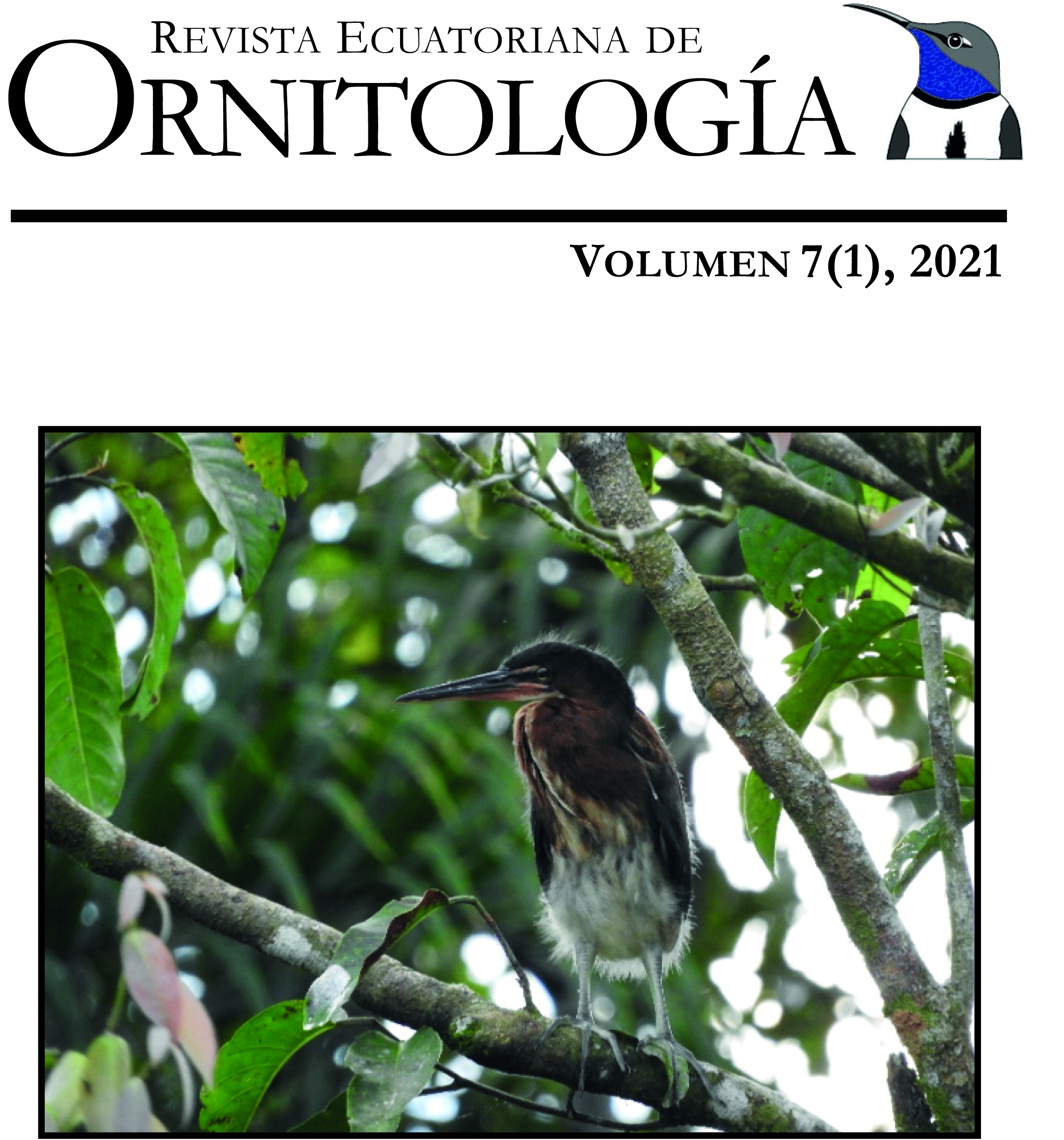Español
DOI:
https://doi.org/10.18272/reo.v7i1.1562Keywords:
clay, gastroliths, minerals, Catamenia inornata, Passer domesticus, Pheucticus chrysogaster, Spinus magellanicusAbstract
Geophagy is the intentional ingestion of soil, there are few records of this behavior in passerines and neither formally reported in Ecuador. We describe the observation of Golden Grosbeak Pheucticus chrysogaster, Hooded Siskin Spinus magellanicus and House Sparrow Passer domesticus ingesting mineral material.
Downloads
References
Best, L. B., & Gionfriddo, J. P. (1991). Characterization of grit use by cornfield birds. Wilson Bulletin, 103(1), 68-82. URL: https://www.jstor.org/stable/4162970
Best, L. B., & Stafford, T. R. (2002). Influence of daily grit consumption rate and diet on gizzard grit counts. Journal of Wildlife Management, 66, 381-391. DOI: https://doi.org/10.2307/3803171
Brightsmith, D. J. (2004). Effects of weather on avian geophagy in Tambopata, Peru. Wilson Bulletin, 116(2), 134-145. DOI: https://doi.org/10.1676/03-087B
Brightsmith, D. J., & Muñoz"Najar, R. A. (2004). Avian geophagy and soil characteristics in southeastern Peru. Biotropica, 36(4), 534-543. DOI: https://doi.org/10.1111/j.1744-7429.2004.tb00348.x
Burger, J., & Gochfeld, M. (2003). Parrot behavior at a Rio Manu (Peru) clay lick: temporal patterns, associations, and antipredator responses. Acta Ethologica, 6, 23-34. DOI: https://doi.org/10.1007/s10211-003-0080-y
Delgado-V, C. A. (2006). Observación de geofagia por el Jilguero Aliblanco Carduelis psaltria (Fringillidae). Boletín de la Sociedad Antioqueña de Ornitología, 16(02), 31-34. URL: http://sao.org.co/publicaciones/
boletinsao/04-Delgado.GeofagiaCarduelis.pdf
Diamond, J., Bishop, K. D., & Gilardi, J. D. (1999). Geophagy in New Guinea birds. Ibis 141, 181-193. DOI: https://doi.org/10.1111/j.1474-919X.1999.tb07540.x
Downs, C. T., Bredin, I. P., & Wragg, P. D. (2019). More than eating dirt: a review of avian geophagy. African Zoology, 54(1), 1-19.
Gilardi, J. D., & Munn, C. A. (1998). Patterns of activity, flocking, and habitat use in parrots of the Peruvian Amazon. Condor, 100(4), 641-653. DOI: https://doi.org/10.2307/1369745
Gilardi, J. D., Duffey, S. S., Munn, C. A., & Tel, L. A. (1999). Biochemical functions of geophagy in parrots: detoxification of dietary toxins and cytoprotective effects. Journal of Chemical Ecology, 25, 897-922. DOI: https://doi.org/10.1023/A:1020857120217
Gionfriddo, J. P., & Best, L. B. (1995). Grit use by house sparrows: effects of diet and grit size. Condor, 97(1), 57-67. DOI: https://doi.org/10.2307/1368983
Graveland, J., & Van Gijzen, T. (1994). Arthropods and seeds are not sufficient as calcium sources for shell formation and skeletal growth in passerines. Ardea, 55(1-2), 299-314. DOI: https://doi.org/10.5253/arde.v82.p299
Graveland, J., & Berends, A. (1997). Timing of the calcium uptake and effect of calcium deficiency on behaviour and egg laying in captive Great Tits, Parus major. Physiological Zoology, 70(1), 74-84. DOI: https://doi.org/10.1086/639547
Mee, A., Denny, R., Fairclough, K., Pullan, D. M., & Boyd-Wallis, W. (2005). Observations of parrots at a geophagy site in Bolivia. Biota Neotropica, 5(2), 321-324. DOI: http://dx.doi.org/10.1590/S1676-06032005000300023
Saiz-Jiménez, C., & Ariño, X. (1995). Colonización biológica y deterioro de morteros por organismos fotótrofos. Materiales de Construcción, 45(240), 5-16. DOI: https://doi.org/10.3989/mc.1995.v45.i240.543
Santos, A., Malagón, P., & Córdoba, E. (2011). Caracterización de arcillas y preparación de pastas cerámicas para la fabricación de tejas y ladrillos en la región de Barichara, Santander. Dyna, 78(167), 53-61. URL: https://www.redalyc.org/articulo.oa?id=49622358006
Simkiss, K. (1967). Calcium in reproductive physiology. London & New York: Chapman & Hall.
Wings O. (2007). A review of gastrolith function with implications for fossil vertebrates and a revised classification. Acta Palaeontologica Polonica, 52, 1-16. URL: http://webaccess.igipz.pan.pl/article/
item/app52-001.html
Downloads
Published
How to Cite
Issue
Section
License
Los autores que publiquen en la Revista Ecuatoriana de Ornitología aceptan los siguientes términos:
- Los autores/as conservarán sus derechos de autor y garantizarán a la revista el derecho de primera publicación de su obra, el cuál estará simultáneamente sujeto a la Licencia de Reconocimiento No Comercial de Creative Commons.
- Los autores/as podrán adoptar otros acuerdos de licencia no exclusiva de distribución de la versión de la obra publicada, pudiendo de esa forma publicarla en un volumen monográfico o reproducirla de otras formas, siempre que se indique la publicación inicial en esta revista.
- Se permite y se recomienda a los autores difundir su obra a través de Internet en su repositorio institucional, página web personal, o red social científica (como ResearchGate o Academia.edu).



